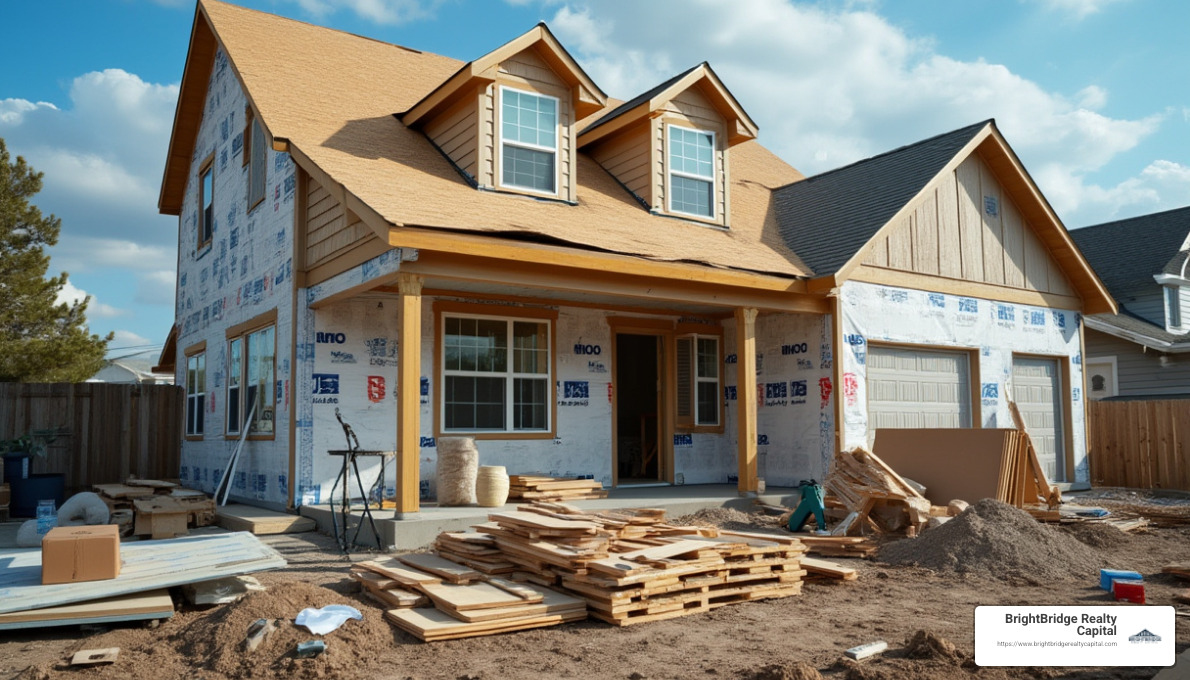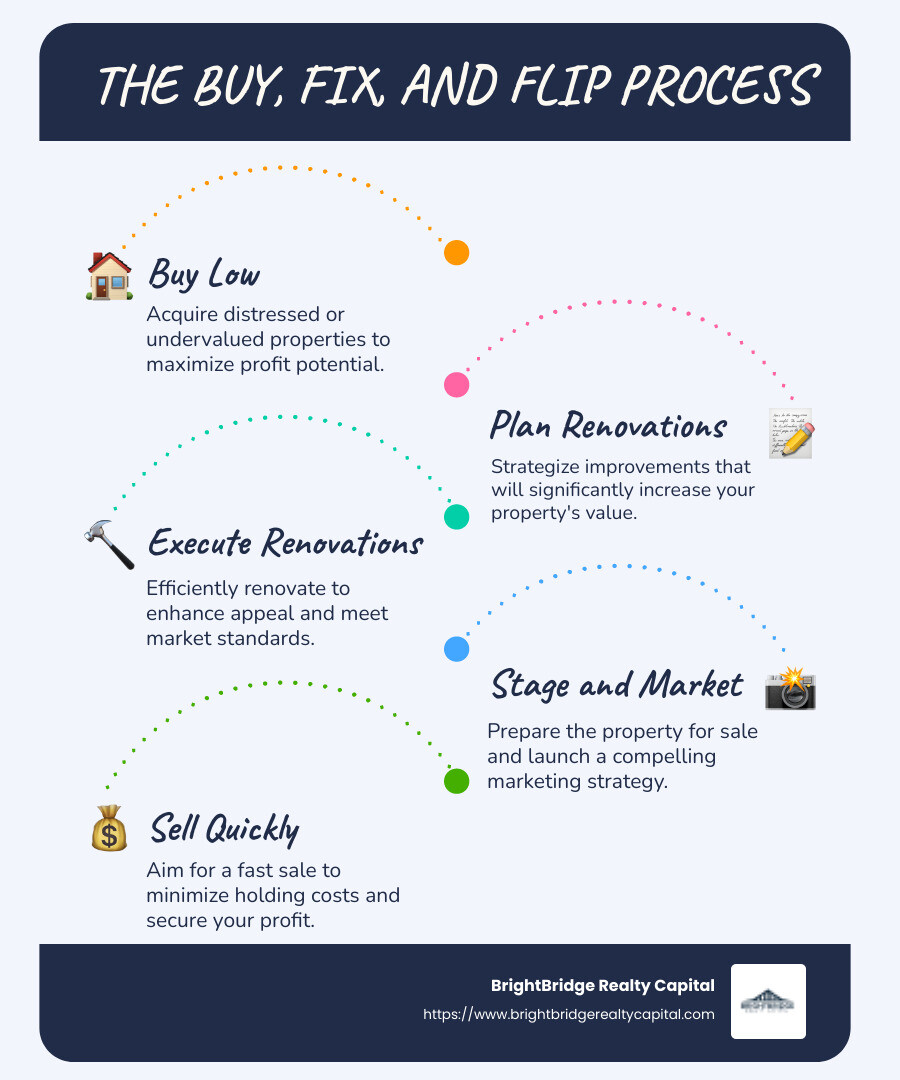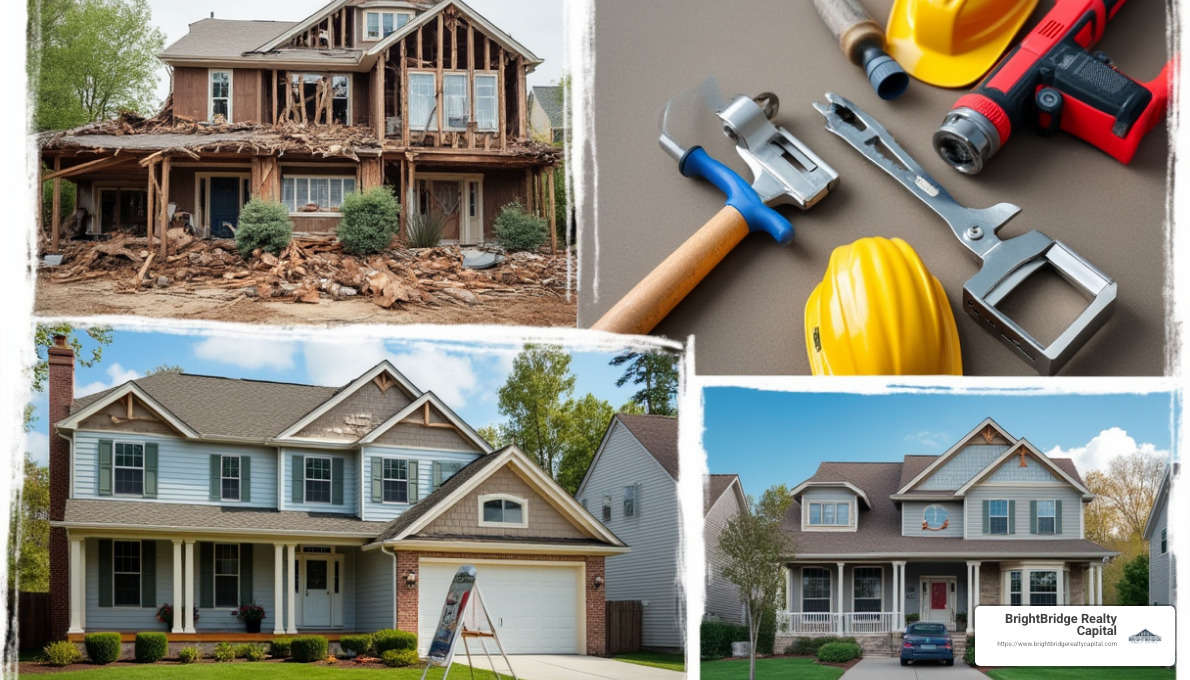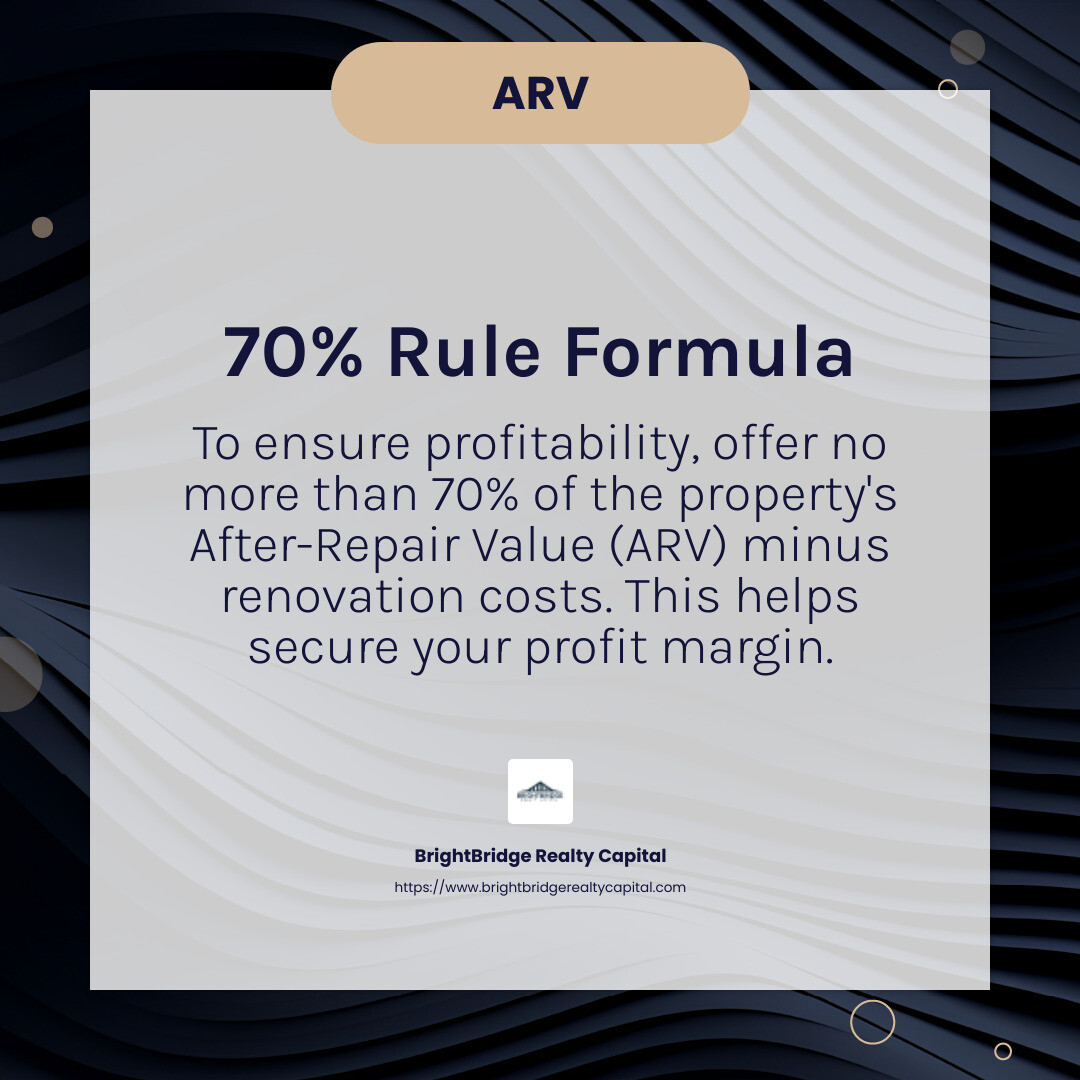Buy, Fix, and Flip: How to Master the Art of Property Flipping

Buy fix and flip is a popular real estate strategy where investors purchase properties, improve them, and sell for profit. It's a thrilling venture, promising not just financial gain but a rewarding glimpse into real estate's dynamic world. Here's a quick snapshot of what this strategy entails:
- Buy Low: Acquire distressed or undervalued properties.
- Fix Efficiently: Renovate smartly to boost the property's appeal and value.
- Flip Fast: Sell quickly to maximize returns and minimize holding costs.
Buying, fixing, and flipping isn't just about quick profits. It's about understanding the real estate market's pulse, leveraging knowledge, and making informed decisions. With careful planning and strategic execution, this method can be a powerful tool for wealth creation.
Mastering this art requires not just an eye for potential but also the right financial partners, like BrightBridge Realty Capital, who offer flexible funding solutions to streamline your project from start to finish. Whether you're new to flipping or looking to expand your portfolio, the right approach can turn a simple property into a lucrative investment.

Common buy fix and flip vocab:
Understanding the Buy, Fix, and Flip Strategy
The buy fix and flip strategy is a real estate investment approach that involves three main steps: buying, renovating, and selling properties quickly. Let's break down each part of this process to understand how it all fits together.
Buying Properties
The first step in this strategy is to find and purchase properties that are undervalued or distressed. These properties are often sold at a discount due to their condition, making them ideal candidates for flipping.
Spotting Opportunities: Look for homes that need work but have good bones. Foreclosures, short sales, or abandoned properties are common targets.
Evaluating Potential: Use the 70% rule to guide your offers. This rule suggests you should pay no more than 70% of the after-repair value (ARV) minus renovation costs. For example, if a home's ARV is $200,000 and it needs $30,000 in repairs, you should aim to pay no more than $110,000.
Renovating Properties
Once you've acquired a property, the next step is to renovate it. The goal is to increase the property's market value through strategic improvements.
Planning Renovations: Focus on updates that offer the highest return on investment. Think kitchens, bathrooms, and curb appeal improvements like landscaping.
Hiring the Right Team: Choose reputable contractors who can deliver quality work on time and within budget. This is crucial for keeping your project on track.
Selling Quickly
After renovations, the final step is to sell the property quickly to capitalize on your investment.
Pricing to Sell: Set a competitive asking price based on the current market and your property's new value. This helps attract buyers and speed up the sale.
Marketing the Property: Use high-quality photos and effective listings to showcase your property's new features. Highlight the renovations and any unique selling points.

The buy fix and flip strategy is not just about buying low and selling high. It's about understanding market dynamics, making smart renovation choices, and timing your sale to maximize profit. With the right approach and partners like BrightBridge Realty Capital, you can turn distressed properties into profitable investments.
Next, we'll explore the 70% rule and how it plays a crucial role in ensuring your flipping ventures are successful.
The 70% Rule: A Key to Success
When diving into buy fix and flip, the 70% rule is your compass. It's a simple yet powerful guideline that helps ensure your investments are profitable. This rule focuses on three key elements: after-repair value (ARV), renovation costs, and profit margin.
Understanding After-Repair Value (ARV)
The after-repair value is the estimated market value of a property after all renovations are complete. It's crucial to get this number right because it influences your buying decisions and sets the stage for your profit calculations.
Research the Market: Look at comparable homes in the area that have recently sold. These comps should be similar in size, style, and age.
Estimate Conservatively: It's better to underestimate the ARV than to overestimate. Being conservative helps protect against market shifts or unexpected expenses.
Calculating Renovation Costs
Renovation costs can quickly eat into your profits if not accurately estimated. This step involves assessing what needs to be fixed or upgraded to reach the desired ARV.
Create a Detailed Budget: List every potential cost, from materials and labor to permits and inspections. Don't forget the small stuff—it adds up!
Work with Experts: Engage contractors or inspectors to provide estimates. Their experience can offer insights you might overlook.
Ensuring a Healthy Profit Margin
Your profit margin is the financial reward for your efforts. The 70% rule helps safeguard this margin by setting a maximum purchase price that allows for both renovation costs and profit.
Apply the 70% Rule: Calculate your maximum offer price using this formula:

If a property's ARV is $250,000 and renovations are estimated at $50,000, your maximum offer should be $125,000. Here's the breakdown:
[250,000 \times 0.70 = 175,000 \175,000 - 50,000 = 125,000]
Factor in Unexpected Costs: Always leave room for unforeseen expenses. Real estate can be unpredictable, and having a buffer can save your project.
The 70% rule is more than a buying strategy; it's a risk management tool. It helps ensure you're not overpaying and that there's room for profit even if things don't go as planned. By following this rule, you'll be better positioned to make smart decisions and achieve success in your buy fix and flip endeavors.
Next, we'll dig into financing options for your fix-and-flip projects, exploring how to secure the funds needed to bring your real estate visions to life.
Financing Your Fix and Flip Project
Securing the right financing is crucial for your buy fix and flip project. This section will guide you through the essentials of fix-and-flip loans, short-term financing, and high leverage options.
Fix-and-Flip Loans: The Basics
Fix-and-flip loans are designed specifically for investors looking to purchase, renovate, and sell properties quickly. These loans offer several advantages:
Quick Approval: Many lenders, like BrightBridge Realty Capital, can approve loans in as little as 1-2 weeks.
Interest-Only Payments: Some loans offer interest-only payment options, which can help manage cash flow during the renovation phase.
Flexible Terms: Loan terms can range from 12 to 24 months, providing flexibility based on your project's timeline.
Short-Term Financing: Speed Matters
In the competitive world of real estate, speed is essential. Short-term financing options allow you to:
Compete with Cash Buyers: Quick closings, sometimes in as few as 7 days, help you stand out against cash buyers.
Adapt to Market Conditions: Short-term loans let you respond quickly to market changes, giving you an edge over slower-moving competitors.
High Leverage: Maximize Your Investment
High leverage loans mean you can borrow a significant portion of the property's purchase price and renovation costs. This approach has several benefits:
Preserve Capital: By financing up to 90% of the purchase price and 100% of the renovation budget, you can keep more of your cash for other investments.
Increase ROI: With less money tied up in a single project, your return on investment can be higher.
Mitigate Risk: Using other people's money reduces your personal financial exposure, making it easier to manage multiple projects simultaneously.
Key Considerations
When choosing a financing option, consider the following:
Interest Rates: Competitive rates can significantly impact your project's profitability. Aim for the lowest rate available to maximize returns.
No Prepayment Penalties: Look for loans without prepayment penalties, allowing you to pay off the loan early if your flip sells quickly.
Loan Transition Options: Some lenders, including BrightBridge Realty Capital, offer the option to transition into a long-term loan once renovations are complete, providing flexibility if you decide to hold the property as a rental.
Finding the right financing is a critical step in your buy fix and flip journey. By leveraging short-term, high-leverage loans, you can efficiently fund your projects and focus on what you do best: changing properties and realizing profits.
Next, we'll explore the practical steps to successfully buy, fix, and flip a property, ensuring your project runs smoothly from start to finish.
Steps to Successfully Buy, Fix, and Flip
Starting on a buy fix and flip project can be rewarding if you follow the right steps. Let's break down the essential components: purchase price, renovation planning, and market timing.
Purchase Price: The Foundation of Profit
The first step in a successful flip is buying the property at the right price. This often means purchasing at a discount, usually due to the property's condition.
Research: Use local market data to understand average home prices and identify undervalued properties. Tools like property auctions and foreclosure listings can be valuable resources.
Offer Wisely: Aim to follow the 70% rule, which suggests that your purchase price should be no more than 70% of the property's after-repair value (ARV) minus renovation costs. This rule helps ensure a healthy profit margin.
Renovation Planning: Maximizing Value
Once you've secured a property, the next step is planning renovations that will improve its value.
Prioritize Repairs: Focus on essential repairs that boost the home's market appeal. Kitchens and bathrooms often offer the best return on investment.
Budget Wisely: Set a realistic renovation budget. Overestimating your DIY skills or underestimating costs can lead to financial strain. Consult with reliable contractors to get accurate estimates.
Timeline Management: Create a detailed renovation timeline. Efficient project management helps avoid costly delays and keeps your financing costs in check.
Market Timing: Selling Smart
Timing your sale is crucial to maximizing profit.
Monitor Market Trends: Stay informed about local real estate trends. Selling during a seller's market, when demand is high, can lead to quicker sales and higher offers.
Flexibility: Be prepared to adjust your selling strategy based on market conditions. If the market shifts, you may need to consider renting the property until conditions improve.
Marketing Savvy: Use high-quality photos and compelling listings to attract potential buyers. Consider hosting open houses to generate interest and competition.
By carefully considering purchase price, planning renovations effectively, and timing your sale strategically, you can master the art of property flipping. Each step is crucial to ensuring your buy fix and flip project is a success.
Next, we'll discuss common mistakes to avoid in property flipping to help you steer potential pitfalls and maximize your profits.
Common Mistakes to Avoid in Property Flipping
Flipping houses can be lucrative, but it's easy to make mistakes that can cost you time and money. Here are some common pitfalls to watch out for:
Underestimating Costs
One of the biggest mistakes is underestimating the total cost of a flip. Beyond the purchase price and renovation expenses, there are holding costs like taxes, insurance, and utilities while you own the property.
Hidden Expenses: Always budget for unexpected costs. These can include unforeseen repairs, permit fees, or delays that extend your timeline.
Financing Costs: If you’re using loans, factor in interest payments. Even a small increase in rates can impact your profit margin.
Remember, a detailed budget is your best friend. It's crucial to stay realistic and cautious with your cost estimations to avoid financial strain.
Overestimating Skills
It's tempting to think you can save money by doing all the work yourself. However, overestimating your DIY skills can lead to costly mistakes and delays.
Know Your Limits: Stick to tasks you’re confident in handling. For specialized work like electrical or plumbing, hiring professionals is often safer and more efficient.
Quality Matters: Poor workmanship can decrease property value and deter buyers. Ensure that all work meets local building codes.
Tip: Consider partnering with skilled contractors. They can provide valuable expertise and help ensure the job is done right the first time.
Market Shifts
The real estate market can be unpredictable. A shift can turn a promising flip into a financial challenge if you're not prepared.
Stay Informed: Keep an eye on local market trends and economic indicators. This knowledge can help you time purchases and sales more effectively.
Flexibility: Be ready to adapt if market conditions change. This could mean adjusting your renovation plans or holding the property longer than planned.
Exit Strategy: Always have a backup plan. If selling isn't profitable, consider renting the property until the market improves.
By avoiding these common mistakes, you can increase your chances of success in the buy fix and flip world. Next, we'll dive into frequently asked questions about this investment strategy to further guide your flipping journey.
Frequently Asked Questions about Buy, Fix, and Flip
Do I Need to Have a Cash Offer to Flip a House?
No, you don't need to have a cash offer to flip a house, but it can be advantageous. Nationwide, about 63% of house flips are purchased with cash. Cash offers are often more attractive to sellers because they tend to close faster and with fewer complications. However, many investors successfully use financing options like fix-and-flip loans. These loans are designed to cover both the purchase and renovation costs, providing high leverage for your investment. If you're considering financing, ensure you understand the terms and costs, as these can affect your profit margin.
How Long Does It Take to Flip a House?
The timeline for flipping a house generally ranges from four to six months, but this can vary based on your experience level and the scope of the project. For novices, it might take longer due to unforeseen challenges and a learning curve. Experienced flippers might streamline the process with a reliable network of contractors and a clear renovation plan. Each project is unique, and factors like property condition, market conditions, and renovation complexity can influence the timeline. Always plan for extra time to accommodate unexpected delays.
Which Cities Are the Best to Flip a House?
Choosing the right location is crucial for a successful flip. Market trends can vary significantly by city, affecting your potential profit. According to Merchants Mortgage, some of the best cities for house flipping in 2024 include Pittsburgh, Buffalo, Baltimore, and Oklahoma City. These cities offer favorable conditions like affordable property prices and strong buyer demand. When selecting a location, consider factors such as local economic growth, housing supply, and demand dynamics. Staying informed about market trends will help you make savvy investment decisions and maximize your returns in the buy fix and flip market.
Conclusion
In real estate investment, the buy, fix, and flip strategy stands out for its potential to deliver impressive returns. However, success in this field hinges on making informed decisions, from purchasing properties at the right price to timing the market effectively. At BrightBridge Realty Capital, we understand the complexities and challenges of this investment strategy. That's why we offer custom real estate financing solutions designed to support your endeavors.
Our commitment to fast closings—often within a week—ensures that you can seize opportunities as they arise, without the usual delays that can hinder progress. As direct lenders, we provide a seamless process with competitive rates, enabling you to focus on what matters most: changing properties and maximizing profits.
Whether you're a seasoned investor or just starting, our team is here to guide you through every step of the journey. We specialize in quick, flexible funding solutions that empower you to tackle any project with confidence. Let us help you open up the potential of your investment portfolio with our expert financing services.
For more information on how we can support your buy, fix, and flip projects, visit our BrightBridge Realty Capital page to explore our offerings and get started on your next successful flip today.


